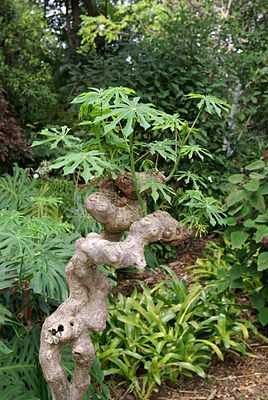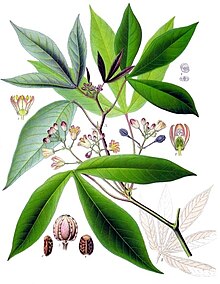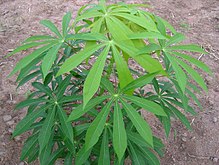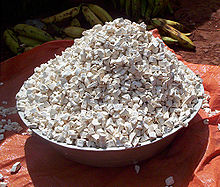Manihot
| Manihot | ||||||||||||
|---|---|---|---|---|---|---|---|---|---|---|---|---|

|
||||||||||||
| Systematics | ||||||||||||
|
||||||||||||
| Scientific name | ||||||||||||
| Manihot | ||||||||||||
| Mill. |
Manihot is a genus of plants from the milkweed family(Euphorbiaceae). Common names for these types of plants are cassava , mandioca , cassava or, in Latin America, yuca . The genus Manihot distinguishes between 60 and 100 species. Some species are grown in the tropics to provide starch. All the cultivated species are given the above name, depending on the region. The most important type is manioc ( Manihot esculenta ). The plant is widely grown because of its starchy root. It originally comes from today'sBrazil and Paraguay and was used by the indigenous peoples for food even before the discovery of America by the Europeans. It is now grown worldwide in many parts of the tropics and subtropics .
description
Manioc styles are trees , shrubs , half-shrubs or herbaceous plants . They contain white milky juice . Some species have tubers. The alternate leaves are divided simply or hand-shaped. The petioles are long. The stipules are small.
The plants are mostly single-sexed ( monoecious ), rarely dioecious and separate-sexed ( dioecious ). The flowers are in several simple or compound, often terminal racemose or trugdoldigen inflorescences . The unisexual flowers are five-fold. The inflorescence consists of only five sepals , the petals are missing. The male flowers contain eight to 15 free stamens in two circles. In addition to the pistil, the female flowers sometimes contain some staminodes . They form tripartite capsule fruits .






Systematics
The genus Manihot was established in 1754 by the English botanist Philip Miller . Today, within the genus, there are around 60 to 100 species, all of which come from the Neotropic , mostly from Brazil.
In the following list of around 100 recognized species, in addition to the botanical author abbreviation, the publication with the year of publication of the first description is given including the area of distribution:
- Manihot acuminatissima garbage. Arg. in CFP by Martius & auct. suc. (eds.), Fl. Bras. 11 (2): 455 (1874): Brazil.
- Manihot aesculifolia (Kunth) Pohl , Pl. Bras. Icon. Descr. 1: 55 (1827): Mexico to Panama.
- Manihot allemii M.J.Silva , Nordic J. Bot. 34: 135 (2016): Brazil.
- Manihot alterniflora P. Carvalho & M. Martins , Nordic J. Bot. 36 (3) -e01615: 2 (2018): Brazil.
- Manihot alutacea D.J. Rogers & Appan , Fl. Neotrope. Monogr. 13: 130 (1973): Brazil.
- Manihot angustiloba (Torr.) Garbage.Arg. in APde Candolle, Prodr. 15 (2): 1073 (1866): Arizona to Mexico.
- Manihot anisophylla (Griseb.) Müll.Arg. , J. Bot. 12: 230 (1874): Bolivia to Argentina.
- Manihot anomala Pohl , Pl. Bras. Icon. Descr. 1: 27 (1827): Venezuela to Peru and Argentina. There are five subspecies.
- Manihot appanii M.J. Silva , Syst. Bot. 40: 168 (2015): Brazil.
- Manihot arenaria M. Mend. , Brittonia 66: 108 (2013): Bolivia.
- Manihot attenuata garbage. Arg. in CFP by Martius & auct. suc. (eds.), Fl. Bras. 11 (2): 443 (1874): Brazil.
- Manihot auriculata McVaugh , Brittonia 13: 190 (1961): Mexico.
- Manihot baccata Allem , Int. J. Pl. Sci. 160: 181 (1999): French Guiana to Northern and Eastern Brazil.
- Manihot bellidifolia P. Carvalho & M. Martins , Syst. Bot. 39: 485 (2014): Brazil.
- Manihot boliviana Pax & K. Hoffm. in HGAEngler (ed.), Pflanzenr., IV, 147, VII: 402 (1914): Bolivia.
- Manihot brachyandra Pax & K.Hoffm. in HGAEngler, Pflanzenr., IV, 147, XVI: 196 (1924): Brazil.
- Manihot brachyloba garbage. Arg . in CFP by Martius & auct. suc. (eds.), Fl. Bras. 11 (2): 451 (1874): Hispaniola, Nicaragua, Costa Rica, and tropical South America.
- Manihot brasiliana M. Mend. & TBCavalc. , Rodriguésia 69: 916 (2018): Brazil.
- Manihot breviloba P. Carvalho & M. Martins , Phytotaxa 32: 58 (2011): Brazil.
- Manihot caerulescens Pohl , Pl. Bras. Icon. Descr. 1: 56 (1827): Brazil to Paraguay. There are four subspecies.
- Manihot carthagenensis (Jacq.) Müll.Arg. in APde Candolle, Prodr. 15 (2): 1073 (1866): Southern Caribbean to Brazil. There are three subspecies.
- Manihot catingae Ule , Bot. Jahrb. Syst. 42: 221 (1908): Brazil.
- Manihot caudata Greenm. , Proc. Amer. Acad. Arts 32: 82 (1903): Northern and Western Mexico.
- Manihot cecropiifolia Pohl , Pl. Bras. Icon. Descr. 1:49 (1827): Brazil.
- Manihot cezarii M. Martins , Novon 24: 179 (2015): Brazil.
- Manihot chlorosticta Standl. & Goldman , Contr. US Natl. Herb. 13: 375 (1911): Mexico.
- Manihot coimbrana M. Mend. , Revista Soc. Boliv. Bot. 9: 8 (2016): Bolivia to western Brazil.
- Manihot compositifolia Allem , Revista Brasil. Biol. 49: 650 (1989 publ. 1990): Brazil.
- Manihot condensata D.J. Rogers & Appan , Fl. Neotrope. Monogr. 13: 100 (1973): Bolivia.
- Manihot confertiflora M.J. Silva , Phytotaxa 213: 133 (2015): Brazil.
- Manihot congesta M. Mend. & TBCavalc. , Rodriguésia 69: 919 (2018): Brazil.
- Manihot corymbiflora Pax & K. Hoffm. in HGAEngler, Pflanzenr., IV, 147, II: 80 (1910): Brazil.
- Manihot crassisepala Pax & K.Hoffm. in HGAEngler, Pflanzenr., IV, 147, II: 28 (1910): Mexico.
- Manihot crotalariiformis Pohl , Pl. Bras. Icon. Descr. 1:24 (1827): Brazil.
- Manihot davisiae Croizat , J. Arnold Arbor. 23: 224 (1942): Arizona to Mexico.
- Manihot debilis M. Mend. & TBCavalc. , Arnaldoa 22: 299 (2015): Brazil.
- Manihot decurrens M. Mend. & M.Martins , Novon 26:59 (2018): Brazil.
- Manihot diamantinensis Allem , Revista Brasil. Biol. 49: 658 (1989 publ. 1990): Brazil.
- Manihot dichotoma Ule , Tropenpflanzer 11: 863 (1907): Brazil.
- Manihot divergens Pohl , Pl. Bras. Icon. Descr. 1: 41 (1827): Brazil.
- Manihot ebracteata M. Mend. & TBCavalc. , Phytotaxa 273: 149 (2016): Brazil.
- Manihot elongata P. Carvalho & M. Martins , Nordic J. Bot. 36 (3) -e01615: 2 (2018): Brazil.
- Manihot epruinosa Pax & K. Hoffm . in HGAEngler, Pflanzenr., IV, 147, XVI: 196 (1924). (Syn. Manihot floribunda Pax & K.Hoffm. ): Brazil.
- Cassava ( Manihot esculenta Crantz ), Inst.Ri Herb. 1: 167 (1766). ( Syn. Manihot edule A. Rich. , Manihot loureiri Pohl , Manihot manihot (L.) Cockerell , Jatropha manihot L. , Manihot melanobasis Muell. Arg. ): Western South America to Brazil.
- Manihot fabianae M. Mend. , Brittonia 66: 110 (2013): Bolivia.
- Manihot falcata D.J. Rogers & Appan , Fl. Neotrope. Monogr. 13: 125 (1973): Brazil.
- Manihot fallax M.J. Silva & LSInocencio , PhytoKeys 91: 141 (2017): Brazil.
- Manihot filamentosa Pittier , J. Wash. Acad. Sci. 20:11 (1930): Northwestern Venezuela.
- Manihot flemingiana D.J. Rogers & Appan , Fl. Neotrope. Monogr. 13: 143 (1973): Brazil.
- Manihot foetida (Kunth) Pohl , Pl. Bras. Icon. Descr. 1:55 (1827): Mexico.
- Manihot fortalezensis Nassar, DGRibeiro, Bomfim & PTCGomes , Genet. Resources Crop Evol. 58: 832 (2011): Brazil.
- Manihot fruticulosa (Pax) DJ Rogers & Appan , Fl. Neotrope. Monogr. 13: 149 (1973): Central Brazil.
- Manihot gabrielensis Allem , Revista Brasil. Biol. 49: 653 (1989 publ. 1990): Brazil.
- Manihot glaziovii Müll.Arg. : Northeastern Brazil. It is also placed as a subspecies to Manihot carthagenensis .
- Manihot gracilis Pohl , Pl. Bras. Icon. Descr. 1: 23 (1827): Central Brazil to Paraguay. There are two subspecies.
- Manihot grahamii Hook. , Hooker's Icon. Pl. 11: t. 530 (1843): Bolivia to Brazil and northern Argentina.
- Manihot gratiosa M.J. Silva , Nordic J. Bot. 34: 66 (2016): Brazil.
- Manihot guaranitica Chodat & Hassl. , Bull. Herb. Boissier, II, 5: 671 (1905): Southeastern Bolivia to northern Argentina.
- Manihot hahnii M. Martins & T. Silveira , Molec. Phylogues. Evol. 132: 213 (2018): Brazil.
- Manihot handroana Cruz , Brogantia 26: 318 (1967): Brazil.
- Manihot hassleriana Chodat , Bull. Herb. Boissier, II, 5: 672 (1905): Paraguay.
- Manihot heptaphylla Ule , Tropenpflanzer 11: 863 (1907): Brazil.
- Manihot hilariana Baill. , Adansonia 4: 282 (1864): Brazil.
- Manihot hunzikeriana Mart.Crov. , Bonplandia (Corrientes) 1: 273 (1964): Brazil and Argentina.
- Manihot incisa M. Mend. & TBCavalc. , Rodriguésia 69: 922 (2018): Brazil.
- Manihot inflata garbage. Arg. in CFP by Martius & auct. suc. (eds.), Fl. Bras. 11 (2): 450 (1874): Brazil.
- Manihot irwinii D.J. Rogers & Appan , Fl. Neotrope. Monogr. 13: 137 (1973): Brazil.
- Manihot jacobinensis Garbage. Arg . , Linnaea 34: 205 (1865). (Syn .: Manihot occidentalis Muell. Arg. , Manihot rigidifolia Pax & K. Hoffmann ): Brazil.
- Manihot janiphoid garbage. Arg . in CFP by Martius & auct. suc. (eds.), Fl. Bras. 11 (2): 480 (1874): Brazil.
- Manihot jolyana Cruz , Brogantia 24: 360 (1965): Brazil.
- Manihot kalungae M.J. Silva & Sodré , Phytotaxa 131: 54 (2013): Brazil.
- Manihot leptophylla Pax & K. Hoffm. in HGAEngler, Pflanzenr., IV, 147, II: 57 (1910): Northern South America to northern and northeastern Brazil.
- Manihot longepetiolata Pohl , Pl. Bras. Icon. Descr. 1:25 (1827): Brazil.
- Manihot longiracemosa P. Carvalho & M. Martins , Syst. Bot. 39: 487 (2014): Brazil.
- Manihot lourdesiae M.J. Silva , Nordic J. Bot. 34: 69 (2016): Brazil.
- Manihot luxurians M.J. Silva , Phytotaxa 213: 135 (2015): Brazil.
- Manihot macrocarpa P. Carvalho & M. Martins , Phytotaxa 309 (2): 179 (2017): Brazil.
- Manihot maguireana D.J. Rogers & Appan , Fl. Neotrope. Monogr. 13: 161 (1973). It occurs from northern South America to Brazil. It is also known as the subspecies Manihot tristis subsp. saxicola (Lanj.) DJ Rogers & Appan posed to Maniho tristis .
- Manihot maracasensis Ule , Bot. Jahrb. Syst. 42: 221 (1908): Brazil.
- Manihot marajoara Huber , Bol. Mus. Goeldi Hist. Nat. Ethnogr. 5: 120 (1908): Brazil.
- Manihot mcvaughii V.W. Steinm. , Contr. Univ. Michigan Herb. 24: 184 (2005): Mexico.
- Manihot membranacea Pax & K. Hoffm. in HGAEngler, Pflanzenr., IV, 147, III: 111 (1911): Brazil.
- Manihot michaelis McVaugh , Brittonia 13: 190 (1961): Southwestern Mexico.
- Manihot minima M. Mend. & TBCavalc. , Arnaldoa 22: 303 (2015): Brazil.
- Manihot mirabilis Pax in HGAEngler, Pflanzenr., IV, 147, II: 91 (1910): Paraguay.
- Manihot montana M.J. Silva , Phytotaxa 403: 211 (2019): Brazil.
- Manihot mossamedensis Deaf. , Bot. Jahrb. Syst. 21: 442 (1896): Brazil.
- Manihot nana garbage. Arg. in CFP by Martius & auct. suc. (eds.), Fl. Bras. 11 (2): 448 (1874): Brazil.
- Manihot neusana Nassar , Ci. & Cult. 38: 340 (1986): Brazil.
- Manihot nogueirae Allem , Revista Brasil. Biol. 49: 656 (1989 publ. 1990): Brazil.
- Manihot oaxacana D.J. Rogers & Appan , Fl. Neotrope. Monogr. 13:46 (1973): Mexico.
- Manihot obovata J. Jiménez Ram. , Anal Inst. Biol. Univ. Nac. Autón. México, Bot. 60: 52 (1990): Mexico.
- Manihot oligantha Pax & K. Hoffm. in HGAEngler, Pflanzenr., IV, 147, II: 53 (1910): Brazil.
- Manihot orbicularis Pohl , Pl. Bras. Icon. Descr. 1:20 (1827): Brazil.
- Manihot pachycaulis M.J. Silva , Nordic J. Bot. 34: 60 (2016): Brazil.
- Manihot palmata Garbage. Arg. in APde Candolle, Prodr. 15 (2): 1062 (1866): Brazil.
- Manihot pandurata M.Martins & M.Mend. , Novon 26:61 (2018): Brazil.
- Manihot pauciflora Brandegee , Univ. Calif. Publ. Bot. 4: 89 (1910): Mexico.
- Manihot paviifolia Pohl , Pl. Bras. Icon. Descr. 1: 52 (1827): Brazil.
- Manihot peltata Pohl , Pl. Bras. Icon. Descr. 1:18 (1827): Brazil.
- Manihot pentaphylla Pohl , Pl. Bras. Icon. Descr. 1: 53 (1827): Brazil to Paraguay. There are four subspecies.
- Manihot peruviana Garbage. Arg. , Linnaea 34: 206 (1865): Peru.
- Manihot pilosa Pohl , Pl. Bras. Icon. Descr. 1: 55 (1827): Eastern Brazil.
- Manihot pinatiloba M. Mend. & TBCavalc. , Rodriguésia 69: 925 (2018): Brazil.
- Manihot pohliana Müll.Arg. in CFP by Martius & auct. suc. (eds.), Fl. Bras. 11 (2): 464 (1874): Brazil.
- Manihot pohlii Wawra , Flora 47: 252 (1864). Brazil.
- Manihot populifolia Pax in HGAEngler, Pflanzenr., IV, 147, II: 93 (1910): Bolivia and Paraguay.
- Manihot porphyrantha M. Mend. & TBCavalc. , Rodriguésia 69: 928 (2018): Brazil.
- Manihot pringlei S. Watson , Proc. Amer. Acad. Arts 26: 148 (1891): Mexico.
- Manihot procumbens garbage. Arg. , Linnaea 34: 206 (1865): Brazil and Paraguay.
- Manihot pruinosa Pohl , Pl. Bras. Icon. Descr. 1:28 (1827). (Syn .: Manihot pseudopruinosa Pax & K. Hoffmann , Manihot burchellii Muell. Arg. , Jatropa pruinosa Steudel ): Brazil.
- Manihot pseudoglaziovii Pax & K. Hoffm. in HGAEngler, Pflanzenr., IV, 147, XVI: 196 (1924): Brazil.
- Manihot pulchrifolius M.J. Silva , PhytoKeys 77: 102 (2017): Brazil.
- Manihot purpurea M. Mend. & TBCavalc. , Phytotaxa 273: 150 (2016): Brazil.
- Manihot purpureocostata Pohl , Pl. Bras. Icon. Descr. 1:19 (1827): Brazil.
- Manihot pusilla Pohl , Pl. Bras. Icon. Descr. 1: 36 (1827): Brazil.
- Manihot quinquefolia Pohl , Pl. Bras. Icon. Descr. 1: 56 (1827). (Syn .: Jatropa quinquefolia Steudel ): Brazil.
- Manihot quinqueloba Pohl , Pl. Bras. Icon. Descr. 1: 21 (1827): Brazil.
- Manihot quinquepartita Huber ex DJ Rogers & Appan , Fl. Neotrope. Monogr. 13: 196 (1973): Brazil.
- Manihot reflexifolia P. Carvalho & M. Martins , Pl. Syst. Evol. 305: 671 (2019): Brazil.
- Manihot reniformis Pohl , Pl. Bras. Icon. Descr. 1: 56 (1827). (Syn .: Jatropa reniformis Steudel ): Brazil.
- Manihot reptans Pax in HGAEngler, Pflanzenr., IV, 147, II: 30 (1910): Brazil.
- Manihot rhomboidea Garbage. Arg. , Linnaea 34: 205 (1865): Mexico to Nicaragua. There are two subspecies.
- Manihot rubricaulis I.M.Johnst. , Contr. Gray Herb. 68: 90 (1923): Mexico. There are two subspecies.
- Manihot sagittata M. Mend. & M.Martins , Novon 26:63 (2018): Brazil.
- Manihot sagittatopartita Pohl , Pl. Bras. Icon. Descr. 1: 22 (1827). (Syn .: Jatropha sagittato-partita Steudel ): Brazil.
- Manihot salicifolia Pohl , Pl. Bras. Icon. Descr. 1:18 (1827): Brazil.
- Manihot saxatilis M.J. Silva & Sodré , Syst. Bot. 39: 222 (2014): Brazil.
- Manihot scandens L.S. Inocencio & MJSilva , Syst. Bot. 41: 983 (2016): Brazil.
- Manihot sparsifolia Pohl , Pl. Bras. Icon. Descr. 1:26 (1827): Brazil.
- Manihot stellata M. Mend. , Brittonia 66: 113 (2013): Bolivia.
- Manihot stipularis Pax in HGAEngler, Pflanzenr., IV, 147, II: 50 (1910): Brazil.
- Manihot stricta Baill. , Adansonia 4: 282 (1864): Bolivia, Peru, Brazil.
- Manihot subspicata D.J. Rogers & Appan , Fl. Neotrope. Monogr. 13: 62 (1973): Mexico.
- Manihot surinamensis D.J. Rogers & Appan , Fl. Neotrope. Monogr. 13:80 (1973): Northern South America.
- Manihot takape De Egea Elsam, Peña-Chocarro, Mereles & Céspedes , PhytoKeys 103: 1-12 (2018): Paraguay.
- Manihot tenella Müll.Arg. in CFP by Martius & auct. suc. (eds.), Fl. Bras. 11 (2): 484 (1874): Brazil, Paraguay.
- Manihot tomatophylla Standl. , Amer. Midl. Naturalist 36: 178 (1946): Mexico.
- Manihot tombadorensis M. Mend. & TBCavalc. , Phytotaxa 273: 153 (2016): Brazil.
- Manihot tomentosa Pohl , Pl. Bras. Icon. Descr. 1:50 (1827): Brazil. With two subspecies.
- Manihot triloba (Sessé) McVaugh ex Miranda , Bol. Soc. Bot. México 29:38 (1965): Mexico.
- Manihot tripartita (Spreng.) Müll.Arg. in APde Candolle, Prodr. 15 (2): 1068 (1866): Eastern Bolivia to Brazil and Paraguay. With five subspecies.
- Manihot triphylla Pohl , Pl. Bras. Icon. Descr. 1: 37 (1827): Brazil.
- Manihot tristis Müll.Arg. in CFP by Martius & auct. suc. (eds.), Fl. Bras. 11 (2): 449 (1874): Northern South America to Northern Brazil. With three subspecies.
- Manihot variifolia Pax & K. Hoffm. in HGAEngler, Pflanzenr., IV, 147, II: 85 (1910): Paraguay and Brazil.
- Manihot veadeirensis M.J. Silva , Syst. Bot. 39: 1161 (2014): Brazil.
- Manihot violacea Pohl , Pl. Bras. Icon. Descr. 1:43 (1827): Brazil. With two subspecies.
- Manihot walkerae Croizat , Bull. Torrey Bot. Club 69: 452 (1942): Texas and Mexico.
- Manihot websteri D.J. Rogers & Appan , Fl. Neotrope. Monogr. 13: 72 (1973): Mexico.
- Manihot weddelliana Baill. , Adansonia 4: 281 (1864): Brazil.
- Manihot xavantinensis D.J. Rogers & Appan , Fl. Neotrope. Monogr. 13: 124 (1973): Brazil.
- Manihot zehntneri Ule , Bot. Jahrb. Syst. 50 (114): 10 (1914): Brazil.
use
The 30 to 60 cm long rhizomes, rich in milk sap and starch flour and standing in clusters, contain hydrogen cyanide in some species and are therefore poisonous. Symptoms of poisoning are ataxia , amblyopia . However, the volatile hydrogen cyanide is removed by suitable treatment (strong heating), and good food is then obtained. However, cassava has a low protein content (only about 1.2%) and very few essential amino acids . (Danger of Kwashiorkor syndrome.) To counteract this, we recommend consuming the protein-rich cassava leaves.
The use of the tubers as food goes back to the indigenous people of South America. Cassava is still an important staple food in Brazil today, especially in the north and northeast of the country.
Like many tropical crops, the cassava bush provides a high yield with little effort.
The tubers are peeled, grated and grated, and then soaked. After a few days, the mass is squeezed out, washed through the so-called tipiti and roasted in ovens. The mass that remains in the press provides the manioc or mandioca flour (farinha).
Cassava flour can be used in a similar way to wheat flour. People with allergies to wheat and other grains therefore often use cassava flour as a substitute. It does not contain gluten .
A by-product of the manufacture of cassava flour is starch ("polvilho"), which is roasted and then called " tapioca ".
In other regions, slightly different products are obtained using a modified process; The flour is also used to prepare cakes (for example the Beijus ), which are more or less similar to our bread, and in the Antilles the mandioka flour is mixed with wheat flour and baked into bread (“conaque”).
The fresh root is used as a remedy for ulcers .
The leaves of the cassava are eaten as a vegetable. The seeds of all three types mentioned above have a purging and vomiting effect.
Delicacies that are made from cassava in Brazil are (among others) Beiju , Farofa or Tarubá . A dish that is particularly popular in Peru is “Yuca á la Huancaína”, “Yuquitas” is even available there as a snack at all major fast-food chains.
Cassava is also used intensively and with pleasure in Central Africa ( Cameroon , Gabon , Congo , etc.). The flour (foufou) is often used for a kind of dumpling dough. The tuber is often cooked in steam or water and is often fried. Cassava leaves are also a very popular dish and are made with peanut paste , oil palm fruits, or coconut milk. The manioc sticks (Bibolo) wrapped in palm leaves are very popular (and take some getting used to for European palates). These are made by completely washing out the starch from the cassava flour. This solid, rubbery, tranzlucid substance is eaten as an accompaniment to fish and meat.
swell
Web links
Individual evidence
- ↑ Gard. Dict. Abr. ed. 4 (1754).
- ↑ a b c d e f g h i j k l m n o p q r s t u v w x y z aa ab ac ad ae af ag ah ai aj ak al am an ao ap aq ar as at au av aw ax ay az ba bb bc bd be bf bg bh bi bj bk bl bm bn bo bp bq br bs bt bu bv bw bx by bz ca cb cc cd ce cf cg ch ci cj ck cl cm cn co cp cq cr cs ct cu cv cw cx cy cz da db dc dd de df dg dh di dj dk dl dm dn do dp dq dr ds dt du dv dw dx dy dz ea eb ec ed ee ef eg eh ei ej ek el em en eo ep eq er es et eu ev ew Rafaël Govaerts (Ed.): Manihot. In: World Checklist of Selected Plant Families (WCSP) - The Board of Trustees of the Royal Botanic Gardens, Kew . Retrieved June 12, 2020.






